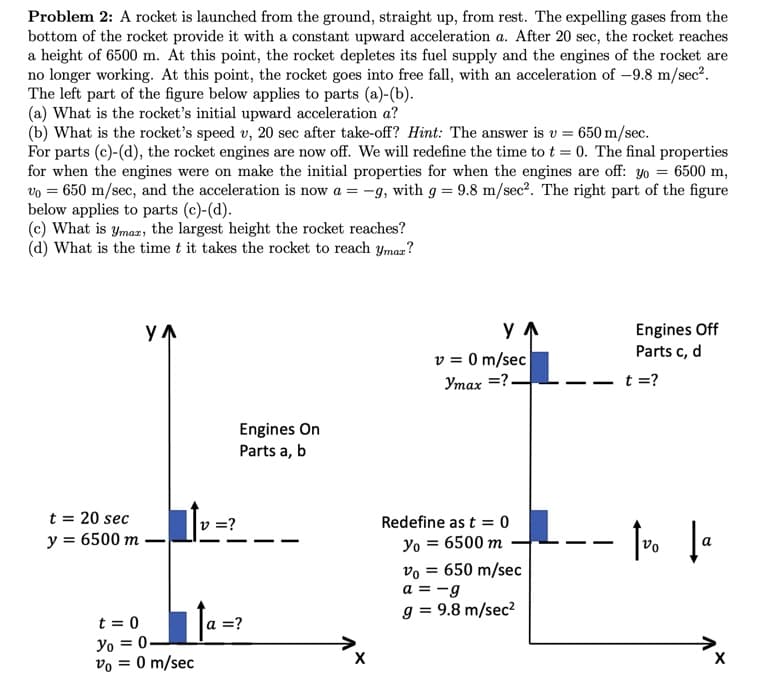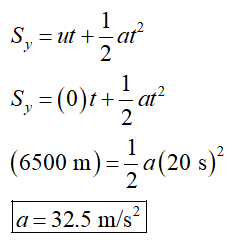Problem 2: A rocket is launched from the ground, straight up, from rest. The expelling gases from the bottom of the rocket provide it with a constant upward acceleration a. After 20 sec, the rocket reaches a height of 6500 m. At this point, the rocket depletes its fuel supply and the engines of the rocket are no longer working. At this point, the rocket goes into free fall, with an acceleration of -9.8 m/sec?. The left part of the figure below applies to parts (a)-(b). (a) What is the rocket's initial upward acceleration a? (b) What is the rocket's speed v, 20 sec after take-off? Hint: The answer is v = 650 m/sec. For parts (c)-(d), the rocket engines are now off. We will redefine the time to t = 0. The final properties for when the engines were on make the initial properties for when the engines are off: yo = 6500 m, vo = 650 m/sec, and the acceleration is now a = -g, with g = 9.8 m/sec2. The right part of the figure below applies to parts (c)-(d). (c) What is ymaz, the largest height the rocket reaches? (d) What is the time t it takes the rocket to reach ymaz?
Problem 2: A rocket is launched from the ground, straight up, from rest. The expelling gases from the bottom of the rocket provide it with a constant upward acceleration a. After 20 sec, the rocket reaches a height of 6500 m. At this point, the rocket depletes its fuel supply and the engines of the rocket are no longer working. At this point, the rocket goes into free fall, with an acceleration of -9.8 m/sec?. The left part of the figure below applies to parts (a)-(b). (a) What is the rocket's initial upward acceleration a? (b) What is the rocket's speed v, 20 sec after take-off? Hint: The answer is v = 650 m/sec. For parts (c)-(d), the rocket engines are now off. We will redefine the time to t = 0. The final properties for when the engines were on make the initial properties for when the engines are off: yo = 6500 m, vo = 650 m/sec, and the acceleration is now a = -g, with g = 9.8 m/sec2. The right part of the figure below applies to parts (c)-(d). (c) What is ymaz, the largest height the rocket reaches? (d) What is the time t it takes the rocket to reach ymaz?
Elements Of Electromagnetics
7th Edition
ISBN:9780190698614
Author:Sadiku, Matthew N. O.
Publisher:Sadiku, Matthew N. O.
ChapterMA: Math Assessment
Section: Chapter Questions
Problem 1.1MA
Related questions
Question
100%

Transcribed Image Text:Problem 2: A rocket is launched from the ground, straight up, from rest. The expelling gases from the
bottom of the rocket provide it with a constant upward acceleration a. After 20 sec, the rocket reaches
a height of 6500 m. At this point, the rocket depletes its fuel supply and the engines of the rocket are
no longer working. At this point, the rocket goes into free fall, with an acceleration of –9.8 m/sec2.
The left part of the figure below applies to parts (a)-(b).
(a) What is the rocket's initial upward acceleration a?
(b) What is the rocket's speed v, 20 sec after take-off? Hint: The answer is v = 650 m/sec.
For parts (c)-(d), the rocket engines are now off. We will redefine the time to t = 0. The final properties
for when the engines were on make the initial properties for when the engines are off: y0 = 6500 m,
vo = 650 m/sec, and the acceleration is now a = -g, with g = 9.8 m/sec?. The right part of the figure
below applies to parts (c)-(d).
(c) What is ymaz, the largest height the rocket reaches?
(d) What is the time t it takes the rocket to reach ymaz?
ул
Engines Off
Parts c, d
ул
v = 0 m/sec
Ymax =?.
t =?
Engines On
Parts a, b
t = 20 sec
y = 6500 m
v =?
Redefine as t = 0
Yo = 6500 m
vo = 650 m/sec
a = -g
g = 9.8 m/sec?
%3D
t = 0
a =?
Yo = 0.
vo = 0 m/sec
Expert Solution
Step 1
(a)
Given data:

From the kinematic equation of motion,

Trending now
This is a popular solution!
Step by step
Solved in 4 steps with 6 images

Knowledge Booster
Learn more about
Need a deep-dive on the concept behind this application? Look no further. Learn more about this topic, mechanical-engineering and related others by exploring similar questions and additional content below.Recommended textbooks for you

Elements Of Electromagnetics
Mechanical Engineering
ISBN:
9780190698614
Author:
Sadiku, Matthew N. O.
Publisher:
Oxford University Press

Mechanics of Materials (10th Edition)
Mechanical Engineering
ISBN:
9780134319650
Author:
Russell C. Hibbeler
Publisher:
PEARSON

Thermodynamics: An Engineering Approach
Mechanical Engineering
ISBN:
9781259822674
Author:
Yunus A. Cengel Dr., Michael A. Boles
Publisher:
McGraw-Hill Education

Elements Of Electromagnetics
Mechanical Engineering
ISBN:
9780190698614
Author:
Sadiku, Matthew N. O.
Publisher:
Oxford University Press

Mechanics of Materials (10th Edition)
Mechanical Engineering
ISBN:
9780134319650
Author:
Russell C. Hibbeler
Publisher:
PEARSON

Thermodynamics: An Engineering Approach
Mechanical Engineering
ISBN:
9781259822674
Author:
Yunus A. Cengel Dr., Michael A. Boles
Publisher:
McGraw-Hill Education

Control Systems Engineering
Mechanical Engineering
ISBN:
9781118170519
Author:
Norman S. Nise
Publisher:
WILEY

Mechanics of Materials (MindTap Course List)
Mechanical Engineering
ISBN:
9781337093347
Author:
Barry J. Goodno, James M. Gere
Publisher:
Cengage Learning

Engineering Mechanics: Statics
Mechanical Engineering
ISBN:
9781118807330
Author:
James L. Meriam, L. G. Kraige, J. N. Bolton
Publisher:
WILEY